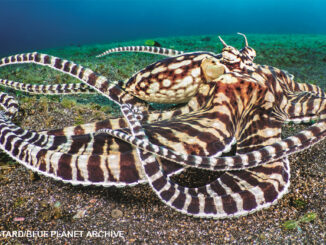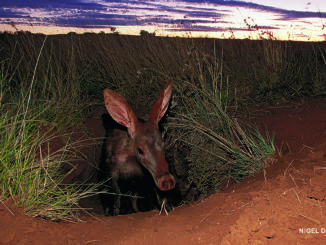
Great Hammerhead Sharks
By Jillian MorrisThis shark isn’t just supersized and super cool. It has superpowers, too!
Meet the great hammerhead shark. The first thing you’ll notice about it is its most famous feature: that amazing hammer-shaped head. This nutty noggin may look unusual, but you’ll soon see it’s super useful. “Head” on over and keep reading to learn more!
SUPER SENSES
There are 10 species of hammerheads in the world, and great hammerheads are the biggest. They can reach 20 feet in length, four to five times longer than you are tall! They live in warm waters around the world.
But let’s dive into those superpowers. Most of the hammerhead’s powers come from its one-of-a-kind head, which is called a cephalofoil (SEF-uh-luh-foyl). Thanks to the head’s broad, hammer-like shape, the great hammerhead shark has super vision. Its eyes are spread far apart, one on each side of the “hammer.” This gives the shark almost 360-degree vision—it can see in front, behind, and all around at the same time! This helps the shark spot prey, avoid danger, and find its way around in the ocean.

PICKING UP SIGNALS
Sharks have the same five senses we do, including great hearing and a strong sense of smell. But they also have a couple of extras to help them survive in the ocean. One of their superpowered senses is called electroreception (ee-LEKtroh-ree-SEP-shun).
This lets sharks “feel” electricity in the water. Most animals, including you, give off tiny electrical signals when their muscles move or their hearts beat. Sharks can detect these signals using tiny gel-filled openings called ampullae (am-POO-lee) of Lorenzini (loor-en-ZEE-nee). The great hammerhead’s cephalofoil is covered with these superpowered sensors. They act as little antennas, picking up electrical signals even if they’re coming from an animal hiding under the sand.

USING ITS HEAD
Buried in the sand is right where the great hammerhead finds its favorite food: stingrays. Once it has found a stingray using electroreception, the shark pins the stingray down with its giant head! Stingrays have stinging barbs on their tails. But the great hammerhead has another superpower: It seems unbothered by a “spicy” stingray meal. Great hammerheads have even been found with dozens of stingray barbs stuck in their mouths.

FEELING ITS WAY
Not all the great hammerhead’s superpowers come from its cephalofoil. Another of its extra senses comes from using its lateral line, which runs along each side of the shark’s body. This special line is made up of fluid-filled canals. These help the shark feel vibrations in the water. Movements such as splashing, swimming, or even fin-wiggling all make vibrations that the shark can feel with its lateral line. This fantastic sense helps a shark find food, avoid danger, and explore its underwater world as though it were an ocean superhero!

SUPER SIDE-SWIMMER
A great hammerhead has a dorsal fin (the one that sticks straight up from its back) that may be as tall as you are. It helps the shark make tight and fast turns when it chases prey such as stingrays and small sharks. But it also helps with swimming. Think of how an airplane’s big, broad wings help it fly. By swimming on its side, a great hammerhead uses its dorsal fin as a wide “wing” that helps lift it. That means the shark can use less energy to swim. Side-swimming is a superpower that helps hammerheads travel long distances. It’s the best way to “fly” through the ocean!
HOPE FOR HAMMERHEADS
Despite all their fantastic superpowers, great hammerhead sharks are in big trouble. They are a critically endangered species, which means that, if we don’t help them, they might become extinct. Overfishing sharks (taking too many from the ocean) is the biggest threat to great hammerheads, as well as to other species. Threats also include habitat loss, plastic trash, and pollution. You can help sharks by learning about them, sharing shark facts with family and friends, and using less plastic. We can all make a difference!
QUEEN OF THE SEA
I scuba dive with great hammerhead sharks off the coast of Bimini, an island in The Bahamas. (The Bahamas is a country made up of islands off the coast of Florida.) Queen is the largest great hammerhead that comes here. And she isn’t just any shark—she’s a true ocean queen. At just over 14 feet long, she’s the length of some cars!
 We can identify Queen by her size and the unique pattern on her underside (right). Also, her side fins turn upwards, making a trail in the sand when she swims over the bottom. Queen is a gentle giant and one of my favorite sharks to dive with. Being in the ocean and watching an animal that big swim by is very special.
We can identify Queen by her size and the unique pattern on her underside (right). Also, her side fins turn upwards, making a trail in the sand when she swims over the bottom. Queen is a gentle giant and one of my favorite sharks to dive with. Being in the ocean and watching an animal that big swim by is very special.
I love sharing my photos and videos with other people to help them learn about these fascinating animals. Divers from across the globe travel to Bimini to dive with great hammerheads, which come here during the winter. Many hope to see Queen, as she has become a celebrity. I am always excited to see if she will return each year. —Jillian Morris

















